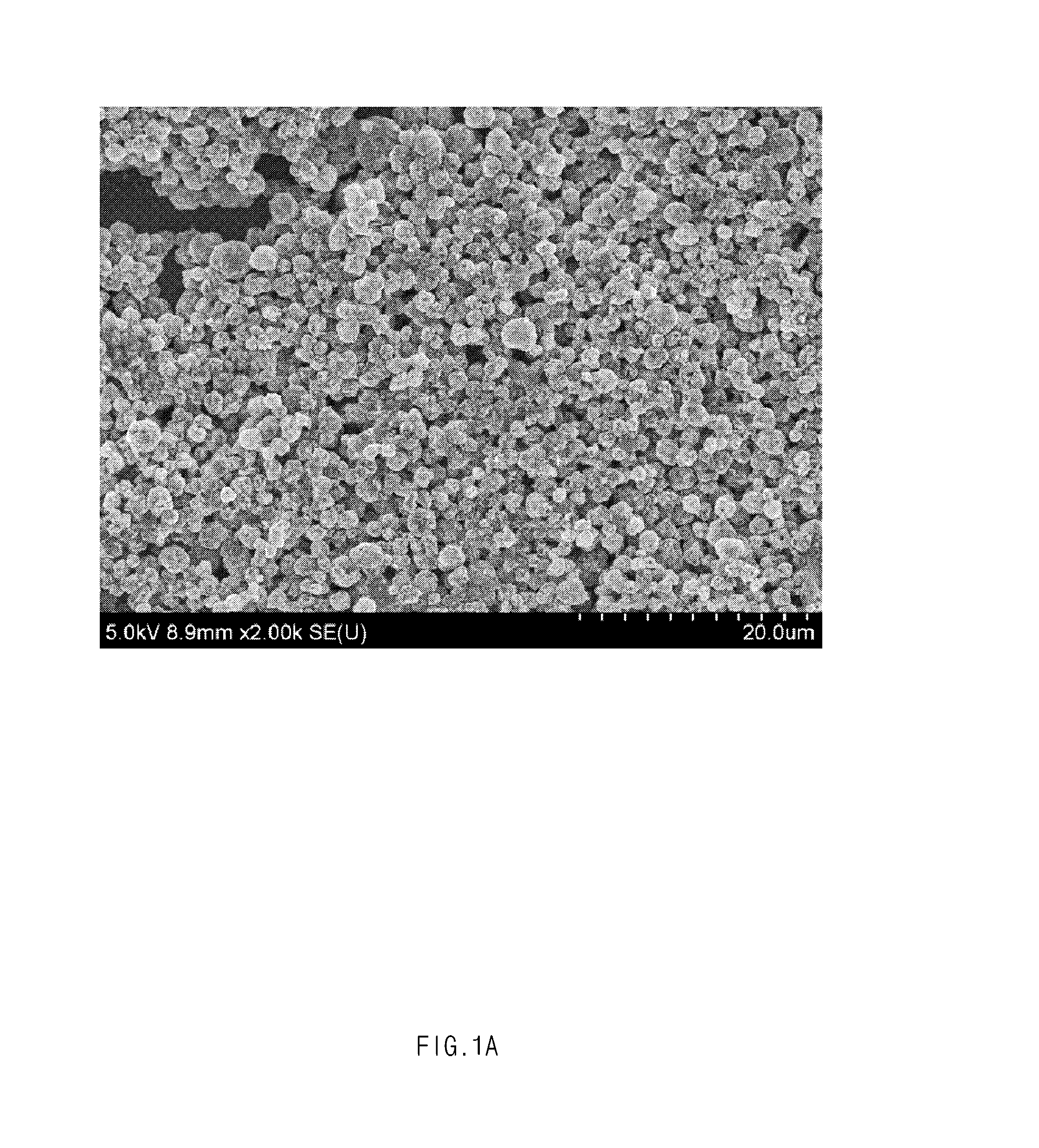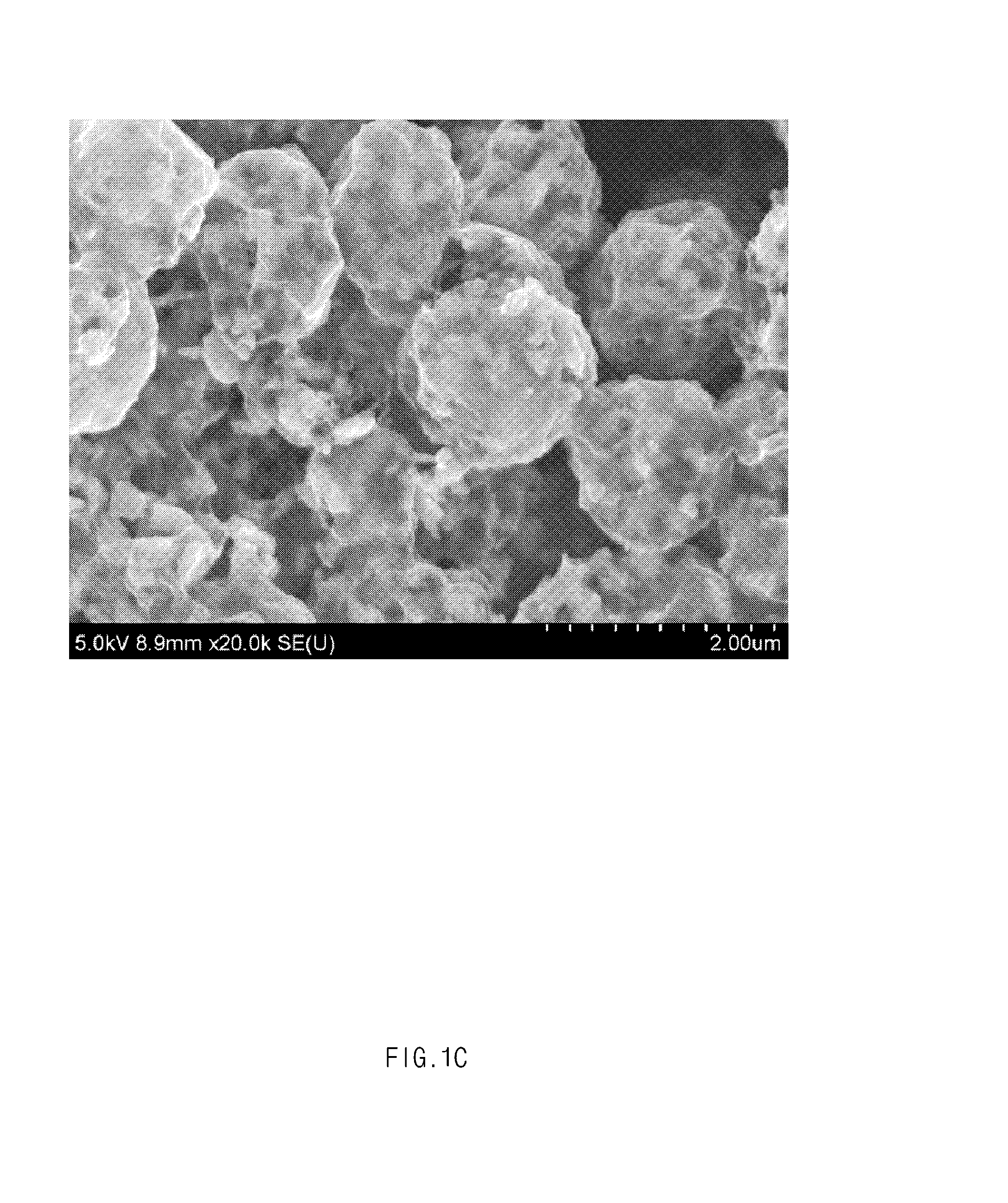Graphene-coated porous silicon-carbon composite and method of manufacturing the same
- Summary
- Abstract
- Description
- Claims
- Application Information
AI Technical Summary
Benefits of technology
Problems solved by technology
Method used
Image
Examples
example 1
Manufacture of Si / CNT / PS / Graphene-Containing Composite
[0131]7 g of Si powder having a diameter of 250 nm, as active particles, was added to an aqueous dispersion in which 0.2 g of carbon nanotubes (hereinafter, referred to as “CNT”) having a diameter of 3 μm, as a conductive material, was dispersed in 500 g of water, and a solution, in which Si particles were dispersed, was then prepared using a mechanical homogenizer and ultrasonication. 7 g of polystyrene beads having an average particle diameter of 200 nm was added as a porogen to the mixed solution and then mixed using a homogenizer to prepare a first mixed solution.
[0132]Subsequently, 7 g of a graphene oxide paste having a concentration of 0.1 wt % was added to the first mixed solution to prepare a second mixed solution.
[0133]The second mixed solution was stirred at 100° C. for 3 hours.
[0134]A graphene oxide-coated Si / C composite precursor was prepared by spray drying the second mixed solution using a spray dryer (model: B-290)...
example 2
Manufacture of Si / C / CNT / PS / Graphene-Containing Composite
[0137]7 g of Si powder having a diameter of 100 nm and 0.7 g of lignosulfonate, as a first carbon precursor, were added to an aqueous dispersion in which 0.2 g of carbon nanotubes (CNT) having a diameter of 3 μm, as a conductive material, was dispersed in 800 g of water, and then stirred for 30 minutes to prepare a solution, in which Si particles were dispersed, using a mechanical homogenizer and ultrasonication. 7 g of polystyrene beads having an average particle diameter of 200 nm was added as a porogen to the mixed solution and then mixed using a homogenizer to prepare a first mixed solution.
[0138]Subsequently, 7 g of a graphene oxide paste having a concentration of 0.1 wt % was added to the first mixed solution to prepare a second mixed solution.
[0139]Next, a graphene oxide-coated Si / C composite precursor was prepared by spray drying the second mixed solution using a B-290 mini spray dryer by Büchi Labortechnika AG at an in...
example 3
Manufacture of Si / C / CNT / PS / Graphene-Containing Composite
[0142]7 g of Si powder having a diameter of 100 nm and 2.1 g of poly-aromatic oxide, as a first carbon precursor, were added to an aqueous dispersion in which 0.2 g of carbon nanotubes (CNT) having a diameter of 3 μm, as a conductive material, was dispersed in 800 g of water, and then stirred for 30 minutes to prepare a solution, in which Si particles were dispersed, using a mechanical homogenizer and ultrasonication. 7 g of polystyrene beads having an average particle diameter of 200 nm was added as a porogen to the mixed solution and then mixed using a homogenizer to prepare a first mixed solution.
[0143]Subsequently, 7 g of a graphene oxide paste having a concentration of 0.1 wt % was added to the first mixed solution to prepare a second mixed solution.
[0144]Next, a graphene oxide-coated Si / C composite precursor was prepared by spray drying the second mixed solution using a B-290 mini spray dryer by Büchi Labortechnika AG at ...
PUM
 Login to View More
Login to View More Abstract
Description
Claims
Application Information
 Login to View More
Login to View More - R&D
- Intellectual Property
- Life Sciences
- Materials
- Tech Scout
- Unparalleled Data Quality
- Higher Quality Content
- 60% Fewer Hallucinations
Browse by: Latest US Patents, China's latest patents, Technical Efficacy Thesaurus, Application Domain, Technology Topic, Popular Technical Reports.
© 2025 PatSnap. All rights reserved.Legal|Privacy policy|Modern Slavery Act Transparency Statement|Sitemap|About US| Contact US: help@patsnap.com



